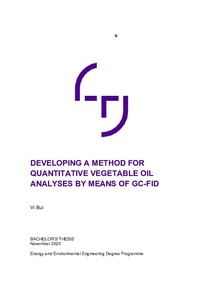Developing a method for quantitative vegetable oil analyses by means of GC-FID
Bui, Vi (2020)
Bui, Vi
2020
All rights reserved. This publication is copyrighted. You may download, display and print it for Your own personal use. Commercial use is prohibited.
Julkaisun pysyvä osoite on
https://urn.fi/URN:NBN:fi:amk-2020120927245
https://urn.fi/URN:NBN:fi:amk-2020120927245
Tiivistelmä
Vegetable oils in general and specialty oils in specific have an important share in human life not only because their health benefits but also because numerous industrial applications they offer. In order to explore those advantages, the need for oils quantitative analyzing is unquestionable. This paper is a part of finalizing a quantitative approach to analyze vegetable oils by GC-FID. This was done by calibrating standard solution using the already developed GC-FID method. The statistical processing of the calibration results gives parameters that will be used in future analysis of vegetable oils.
There were 16 standards being calibrated in total: squalene; 4 methyl esters: methyl palmitate, methyl linoleate, methyl oleate and methyl stearate; 4 fatty acids: palmitic acid, linoleic acid, oleic acid, stearic acid; a-tocopherol; DL-a-palmitin and a mixture of 5 triacylglycerides: tricaprylin, tricaprin, trilaurin, trimyristin, tripalmitin. By measuring the signals of one or more standard samples with known concentration of analyte, response factors (RF) were calculated. RFs of the methyl esters and squalene are slightly similar, range from 1.13 (methyl oleate) to 1.84 (methyl palmitate). A comparable fashion was found in RFs of the first three triacylglycerides: around 1.5 for tricaprylin, tricaprin and trilaurin. The RFs of other two are 2.66 for trimyristin and 3.14 for tripalmitin. Palmitic acid and DL-a-palmitin share a similar RF, approximately 3.2. A-tocopherol (vitamin E) has a small RF at 1.74. Oleic acid has a slightly bigger RF compare to others, at 3.59. The substances own the highest RFs are stearic acid (4.12) and linoleic acid (5.3). Standards retention times, their limit of detection, limit of quantification and calibration curves were also reported.
The findings will provide a strong foundation for vegetable oil analysis using GC-FID. With the data collected, it is possible to indentify and quantify these chemical substances in future oils investigation.
There were 16 standards being calibrated in total: squalene; 4 methyl esters: methyl palmitate, methyl linoleate, methyl oleate and methyl stearate; 4 fatty acids: palmitic acid, linoleic acid, oleic acid, stearic acid; a-tocopherol; DL-a-palmitin and a mixture of 5 triacylglycerides: tricaprylin, tricaprin, trilaurin, trimyristin, tripalmitin. By measuring the signals of one or more standard samples with known concentration of analyte, response factors (RF) were calculated. RFs of the methyl esters and squalene are slightly similar, range from 1.13 (methyl oleate) to 1.84 (methyl palmitate). A comparable fashion was found in RFs of the first three triacylglycerides: around 1.5 for tricaprylin, tricaprin and trilaurin. The RFs of other two are 2.66 for trimyristin and 3.14 for tripalmitin. Palmitic acid and DL-a-palmitin share a similar RF, approximately 3.2. A-tocopherol (vitamin E) has a small RF at 1.74. Oleic acid has a slightly bigger RF compare to others, at 3.59. The substances own the highest RFs are stearic acid (4.12) and linoleic acid (5.3). Standards retention times, their limit of detection, limit of quantification and calibration curves were also reported.
The findings will provide a strong foundation for vegetable oil analysis using GC-FID. With the data collected, it is possible to indentify and quantify these chemical substances in future oils investigation.
